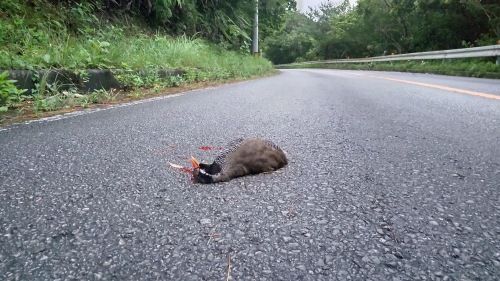Twenty-Four Accidents Involving Yambaru Kuina This Year More Accidents than Last Year, Clinics are “At Capacity”

A dead Yambaru kuina was found on prefectural road Route 2 (Approximately 6 a.m. on July 23, Kunigami (Photograph provided by Takeshi Shimabuku))
July 29, 2021 Ryukyu Shimpo
There have been multiple traffic accidents in Yambaru (northern part of the main island) involving Yambaru kuina (Okinawa rails), a species of bird that is registered as a Natural Monument of Japan. As of July 28, 24 such accidents had been confirmed this year, surpassing the 22 accidents recorded in 2020. Five birds were brought in for treatment and four are still being treated. The clinics treating the birds warn that they are at capacity. In addition to the time required for bone fractures to heal, there are also several birds who cannot be returned to the wild.
The accidents have occurred primarily on Route 2 in Kunigami, and route 70 that connects Kunigami to Higashi. On July 23, yet another dead bird was found on the road. If the examination of the body concludes that it was the victim of a traffic accident, it will be the 25th such accident this year. Takeshi Shimabuku of Ada in Kunigami, who found the dead bird at approximately 6 a.m. on July 23, says that when he found the body, the blood had not yet hardened and the body was still warm. He says, “It’s the second time I have found one this year. It seems like a lot.”
The four birds that were brought in are currently being treated at facilities run by the Ministry of the Environment and the Animal Hospital Okinawa, an NPO in Uruma. One of the birds was in an accident in May, and lost the ability to walk due to a spinal cord injury. Because of the paralysis, the staff helps the bird to defecate. They are currently conducting rehabilitation for the lower half of the bird’s body, but it is unclear how much improvement can be expected. Among the birds who were in accidents, there are other birds who cannot be returned to the wild. In one of these cases, both legs had to be amputated.
Takashi Nagamine, director of the Animal Hospital Okinawa, says that they are facing a new challenge. “We’ve reached a point where we have the skills to save these birds. But the lifespan of a Yambaru kuina is more than 10 years long. We don’t have enough space to care for them long-term.” In addition to calling on drivers to reduce their speed, he adds “if a car has its high beams on, the birds should notice it, and that might help reduce the number of accidents.” In addition to the Yambaru kuina, four Ryukyu long-tailed giant rats, one Okinawa woodpecker, and one Ryukyu robin have also been the hurt in traffic accidents. The long-tailed giant rats and the robin all died in the accidents. The woodpecker is being treated.
(English translation by T&CT and Ellen Huntley)
Previous Article:National government starts coral transplantation, ignores authorization conditions from OPG
Next Article:Emergency conference asks visitors to refrain from visiting Yambaru, warns of collapse of healthcare system in Okinawa’s northern region
[Similar Articles]
- Noguchigera released after road accident
- Road accidents involving Yambaru kuina hit record high
- Pair of Yambaru-Kuina photographed in recommended World Heritage Site, Kunigami
- In light of frequent Yambaru Kuina accidents, drivers asked to take caution and drive slowly
- Yambaru kuina rescued from road accident released in forest
 Webcam(Kokusai Street)
Webcam(Kokusai Street)


